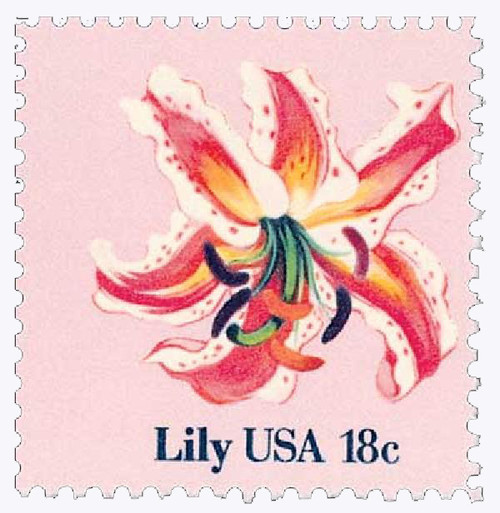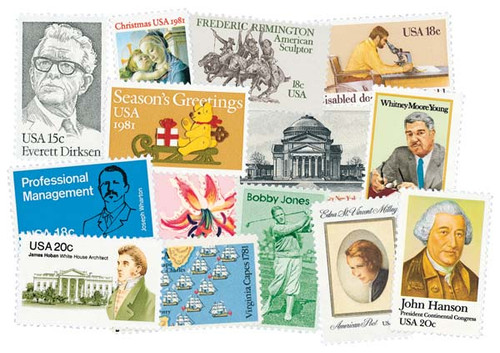
# 1876 - 1981 18c Flowers: Rose
U.S. #1876
1981 18¢ Rose
Flowers
- From the first set of commemoratives issued for the new 18¢ first-class rate
- Created “at the request of President Carter”
Stamp Category: Commemorative
Set: Flowers
Value: 18¢; first-class postage rate
First Day of Issue: April 23, 1981
First Day City: Fort Valley, Georgia
Quantity Issued: 52,658,250
Printed by: Bureau of Engraving & Printing
Printing Method: Photogravure
Format: Panes of 48 in sheets of 192
Perforations: 11
Why the stamp was issued: The block of four Flowers stamps were the first commemoratives issued at the new 18¢ first-class rate that went into effect March 22, 1981.
About the stamp design: The Flowers block was the first stamp assignment for Lowell Nesbitt of New York City, who’s known for creating large-scale paintings of flowers. According to the USPS, the stamp images are “composite interpretations of several of his previous painting not representing specific species of flowers.” The flowers are largely pink and red, taking up most of the stamp space, all on a white background. US #1876 pictures a deep red tea rose.
First Day City: The First Day Ceremony for the Flowers block was held at the headquarters of the American Camellia Society in Fort Valley, Georgia.
About the Flowers Stamps: These stamps are largely the result of campaigning by the American Camellia Society (ACS). The ACS had requested a stamp featuring their signature flower for several years. Some members of the group were friends of former President Jimmy Carter, who was living in Plains, Georgia, near their headquarters in Fort Valley. They appear to have passed their suggestion to the former president, who in turn wrote a letter to the postmaster general asking for a camelia stamp. While the Citizens’ Stamp Advisory Committee initially questioned the importance of a camellia stamp, they ultimately agreed, and expanded the issue to a block of four. In announcing the issue, the USPS said the Flowers block of four was created “at the request of President Carter.”
Other stamps in the set picture:
The American Camellia Society identified the pink-edged, white flower camellia on US #1877 as the “Betty Sheffield Supreme.”
The dahlia stamp on US #1878 pictures what is believed to be a pink and white cactus type of dahlia.
The red spotted white lily on US #1879 is suspected to be an Oriental hybrid variety.
History the stamp represents: Say the word “rose,” and it conjures up images of one of the most beautiful of all flowers. With its delicate, sweet-smelling blossom, this lovely flower has long been a symbol of beauty.
First cultivated in Asia, the rose has become popular in many countries throughout the world. In fact, it is the national flower of the United States, and several states including Georgia, Iowa, and North Dakota have chosen the rose as their state flower.
One of the largest and most important families of flowering plants, the rose family contains over 3,400 species of trees, shrubs, and herbs - including plants that produce fruit, such as pears, peaches, plums, and cherries.
In addition to being used for decoration, the rose provides us with several useful products. Fine woods from its various trees are used in cabinetmaking and woodworking. Attar, an oil obtained from the rose petal is used to make perfumes. And the edible, berrylike “fruit” of the rose, called hips, is used in making teas, jellies, and other preserves.
U.S. #1876
1981 18¢ Rose
Flowers
- From the first set of commemoratives issued for the new 18¢ first-class rate
- Created “at the request of President Carter”
Stamp Category: Commemorative
Set: Flowers
Value: 18¢; first-class postage rate
First Day of Issue: April 23, 1981
First Day City: Fort Valley, Georgia
Quantity Issued: 52,658,250
Printed by: Bureau of Engraving & Printing
Printing Method: Photogravure
Format: Panes of 48 in sheets of 192
Perforations: 11
Why the stamp was issued: The block of four Flowers stamps were the first commemoratives issued at the new 18¢ first-class rate that went into effect March 22, 1981.
About the stamp design: The Flowers block was the first stamp assignment for Lowell Nesbitt of New York City, who’s known for creating large-scale paintings of flowers. According to the USPS, the stamp images are “composite interpretations of several of his previous painting not representing specific species of flowers.” The flowers are largely pink and red, taking up most of the stamp space, all on a white background. US #1876 pictures a deep red tea rose.
First Day City: The First Day Ceremony for the Flowers block was held at the headquarters of the American Camellia Society in Fort Valley, Georgia.
About the Flowers Stamps: These stamps are largely the result of campaigning by the American Camellia Society (ACS). The ACS had requested a stamp featuring their signature flower for several years. Some members of the group were friends of former President Jimmy Carter, who was living in Plains, Georgia, near their headquarters in Fort Valley. They appear to have passed their suggestion to the former president, who in turn wrote a letter to the postmaster general asking for a camelia stamp. While the Citizens’ Stamp Advisory Committee initially questioned the importance of a camellia stamp, they ultimately agreed, and expanded the issue to a block of four. In announcing the issue, the USPS said the Flowers block of four was created “at the request of President Carter.”
Other stamps in the set picture:
The American Camellia Society identified the pink-edged, white flower camellia on US #1877 as the “Betty Sheffield Supreme.”
The dahlia stamp on US #1878 pictures what is believed to be a pink and white cactus type of dahlia.
The red spotted white lily on US #1879 is suspected to be an Oriental hybrid variety.
History the stamp represents: Say the word “rose,” and it conjures up images of one of the most beautiful of all flowers. With its delicate, sweet-smelling blossom, this lovely flower has long been a symbol of beauty.
First cultivated in Asia, the rose has become popular in many countries throughout the world. In fact, it is the national flower of the United States, and several states including Georgia, Iowa, and North Dakota have chosen the rose as their state flower.
One of the largest and most important families of flowering plants, the rose family contains over 3,400 species of trees, shrubs, and herbs - including plants that produce fruit, such as pears, peaches, plums, and cherries.
In addition to being used for decoration, the rose provides us with several useful products. Fine woods from its various trees are used in cabinetmaking and woodworking. Attar, an oil obtained from the rose petal is used to make perfumes. And the edible, berrylike “fruit” of the rose, called hips, is used in making teas, jellies, and other preserves.











